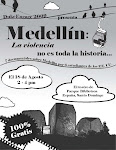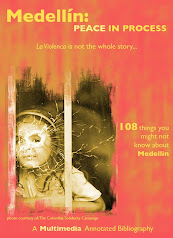"What is culture? How is it recognized and defined? Why is it important? Five minutes at the Tíbiri can quickly answer all of these questions. The United States is commonly criticized as lacking culture (admittedly an inherently subjective and ambiguous term); people assert that the citizens are so consumed with materialism that a national ‘culture’ has never been cultivated. All my life I’ve downplayed this concern, believing it to be invalid and also irrelevant. But at the Tíbiri, I finally realized the basis for that criticism. The Tíbiri is culture. Every aspect of the salsa club, from the casual and carefree way people switch dance partners from song to song (a rare sight at the largely territorial dance clubs in the U.S.), to the “salsa kings” who dance for 6-7 hours on end, to the very grimy, overflowing basement it is located in, is not only foreign and exotic but extremely inviting and refreshing at the same time. At the Tíbiri, two things are instantly recognizable: the people want to enjoy themselves, and they love to dance. When I think back to every club I've ever been in, every college party, every dance, not one holds a candle to the few hours I spent in that cramped basement, for the simple reason that I was instantly immersed in a beautiful, intoxicating, and authentic culture. It’s a club entirely unlike any in the United States, and an experience I wish everyone could have."
"Everyone dances with everyone at all times. No one is left sitting out for long and people swap husbands, wives, students, girlfriends, boyfriends, friends and it doesn’t matter who you’re dancing with as long as you’re dancing. When I suggested that we meet up with the others at the Tíbiri everyone came along, even though it was nearly 2am and I was the only person under 25. In Medellín it seems that barriers of age are broken more easily than in the United States.
I am not sure how to describe the Tíbiri except to use a phrase I learned in Buenos Aires. The Tíbiri is otra cosa. Before we went to the Tíbiri everyone warned us of a few things: it’s hot, it’s crowded, it’s puro salsa. Every one of those things is true. Sweat drips from the low hanging ceiling into your eyes and you can hardly dance because the person next to you is so close but you the music is the best and everyone wants to be there. Salsa is sexy but doesn’t necessarily have to do with sex. It’s hard to be specific trying to describe the Tíbiri because the only way to understand it is to go."
"My first salsa dance was a sufficiently awkward experience, since I thought I had to learn specific steps and stiffly tried to follow my poor partner around the crowded dance floor. After taking a break to sit and watch the action unfold, I was amazed by the pure natural movement of the dancers. Everyone let the music guide them in their own way, with the more practiced partners twirling each other around effortlessly. In the United States, dancing is completely different. Teenagers only know the grinding of high school dances and clubs, with the occasional slow dance; a rare few actually know structured dances such as the waltz or the tango. But even those dances have nothing on the salsa of the Tíbiri in terms of a cultural event. Instead of getting wasted and barely remembering who you danced with – much less how you danced – you have a few drinks, grab a friend, and let loose all your moves. The freedom with which everyone in the Tíbiri danced was beautiful; you could feel the pure exuberance and joy that come hand in hand with confident dancers, good music, and people looking to just have a good time. I’ve learned that when an 82 year-old man asks for your hand to dance at the Tíbiri, you should always say yes – he’ll dance your socks off and you’ll never feel more free on the dance floor again.""Everyone was very open. No one on our side said, “sorry, I think I’ll pass” because they were too embarrassed to try something they had never done before. In return, all of the compañeros wanted to dance with us- to help us learn something new about them. They did this also without embarrassment, and they seemed to really enjoy spending time with us.Finally, what really finished the evening well was that most of the other dancers in the Tíbiri seemed to follow the same code. No one was heavily intoxicated, and everyone was there to enjoy each other and the music. Plenty of people we did not know asked us to dance even though we were new and did not know what we were doing, and some of them even offered to teach me a few things. These elements created the fun, relaxed atmosphere that we all enjoyed on Friday night at the salsa club."
"I really enjoyed salsa dancing at the Tíbiri for a couple of different reasons. First, well, how many people can say that they’ve been salsa dancing in a little, hole-in-the-wall Medellín salsa bar with a bunch of Colombian college students (and the occasional old man)? It’s such a unique experience – and one that I wish that my friends and family could really experience firsthand. Except, maybe minus the heat.I thought that the place itself was really neat. Just entering the Tíbiri is kind of fascinating – it’s kind of like the Comic Cantina in Durham. You’d never really know it was there unless someone else had brought you previously. The atmosphere was great – low-key, lots of people coming in-and-out just to dance, and lots of people coming just to relax and watch some incredible salsa dancers in action. The walls were covered with posters and artwork; I noticed some images of Ché Guevara, and other posters that I couldn’t make out because of the dark lighting. I was also just absolutely floored by how good some of the salsa dancers were. Even the average Colombian seems to be many notches above what I could ever hope to be, and the experts were just phenomenal. Their feet were a blur as they moved around and every twirl and step seemed so easy for them. Everyone is also polite about asking you to dance and also about thanking you after a dance. It’s somewhat different than the culture in the U.S. – people here really just enjoy salsa dancing in its purest form."
El Tíbiri
Here in Medellín there is a salsa club called El Tíbiri. It is unlike anything that exists in the United States. For our bitácora last week, we each reflected on what impressed us most about the Tíbiri. Excerpts below:




September 8, 2012 at 9:41 PM
Post a Comment